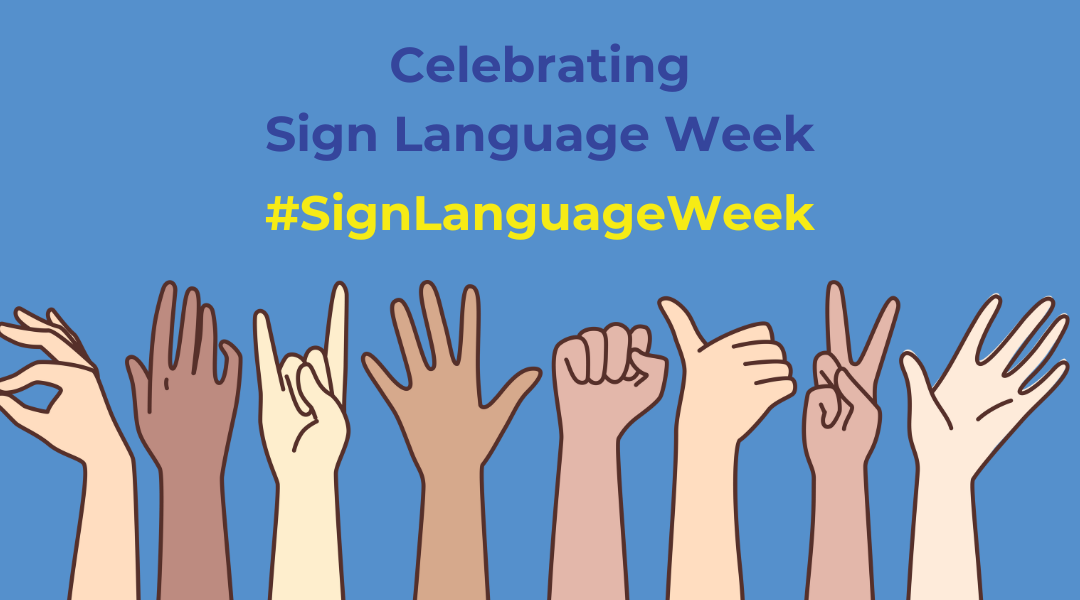Sign Language Week is running from 18th – 24th March 2024 and is run on an annual basis by the British Deaf Association (BDA). It is celebrated each year in March to coincide with the anniversary of the recognition of BSL by the British Government in 2003.
Communication is the cornerstone of human interaction. It’s how we express our thoughts, emotions, and needs. But what happens when traditional spoken language is not accessible? This is where British Sign Language (BSL) steps in, opening doors to communication for the Deaf community in the United Kingdom and beyond. In this blog, we’ll explore the richness and importance of BSL, shedding light on its history, structure, and cultural significance.
A Brief History
British Sign Language has a rich history that dates back centuries. It evolved organically within Deaf communities, shaped by their interactions and experiences. While precise origins are difficult to trace, historical records indicate that sign language was used within Deaf communities long before it was formally recognized.
It wasn’t until the 18th century that formal education for Deaf children began to emerge in Britain, with schools like the Thomas Braidwood’s Academy for the Deaf in Edinburgh playing a pivotal role. Here, signing systems were refined and standardised, laying the groundwork for what would later become British Sign Language.
Structure and Grammar
BSL is a visual-gestural language, utilising handshapes, facial expressions, and body movements to convey meaning. Like spoken languages, it has its own syntax, grammar, and vocabulary. Interestingly, BSL is not simply a direct translation of English into signs; it has its own linguistic structure independent of spoken language.
One of the fascinating aspects of BSL is its use of space and directionality. Signers often use spatial references to indicate relationships between objects, people, and concepts. This spatial grammar adds depth and nuance to communication, allowing for rich expression and clarity of meaning.
Cultural Significance
Beyond its linguistic aspects, BSL holds deep cultural significance for the Deaf community. It is a vital component of Deaf identity and heritage, connecting individuals through a shared mode of communication and expression. Deaf culture encompasses unique traditions, art forms, and social norms, all of which are enriched by the use of BSL.
For many Deaf individuals, BSL is not just a means of communication; it’s a source of pride and empowerment. It enables them to participate fully in society, access information, and engage with others on their own terms. Additionally, BSL plays a crucial role in fostering community cohesion and solidarity within the Deaf community.
Challenges and Advocacy
Despite its importance, BSL still faces challenges in terms of recognition and accessibility. Many Deaf individuals continue to encounter barriers in education, employment, and everyday life due to a lack of understanding and support for their language and communication needs.
Advocacy efforts aimed at promoting BSL awareness and inclusion have made significant strides in recent years. In 2003, BSL was officially recognised as a language in its own right in the UK, marking a crucial milestone for the Deaf community. British Sign Language (BSL) will be taught as a GCSE in England from September 2025, the government says. It says the qualification will be open to all pupils, who will learn about 1,000 signs, as well as an important life skill and advance inclusivity.
Conclusion
British Sign Language is not just a mode of communication; it’s a vibrant and dynamic language that enriches the lives of millions of Deaf individuals around the world. Its history, structure, and cultural significance make it a unique and valuable part of human diversity.
As we continue to strive for inclusivity and equality, it’s essential to recognise the importance of BSL and support efforts to promote its use and understanding. By embracing diversity in communication, we can create a more inclusive and accessible world for everyone. So let’s celebrate, why not join a class, learn and embrace the beauty of British Sign Language.
